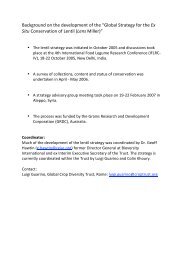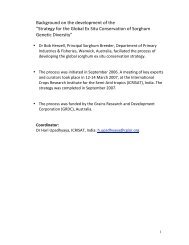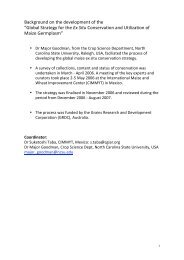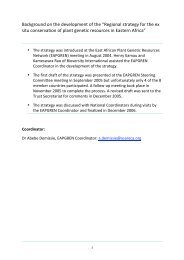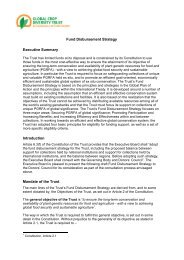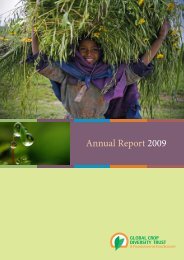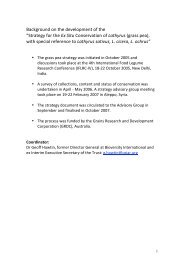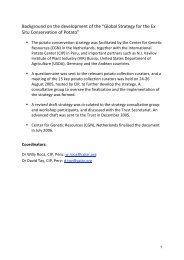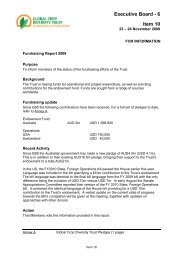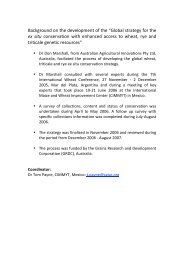Safeguarding the Future of US Agriculture - Global Crop Diversity Trust
Safeguarding the Future of US Agriculture - Global Crop Diversity Trust
Safeguarding the Future of US Agriculture - Global Crop Diversity Trust
Create successful ePaper yourself
Turn your PDF publications into a flip-book with our unique Google optimized e-Paper software.
ConclusionAlthough it is easy to assume that <strong>US</strong> agriculture is relatively self-sufficient, allagriculture in today’s world is interdependent. <strong>Crop</strong> diversity collections are <strong>the</strong>lynchpin <strong>of</strong> this interdependence, and thus central, as well, to <strong>the</strong> future <strong>of</strong> <strong>US</strong>agriculture. <strong>Global</strong> collections <strong>of</strong> crop diversity are a long-term public good, andneed to be supported in <strong>the</strong> public interest.The public good nature <strong>of</strong> crop diversity collections is not always obvious. Forinstance, some assume that private sector agricultural firms will maintain enoughdiversity to ensure food security now and in <strong>the</strong> future. Although <strong>the</strong> biggest firmsdo have impressive genebank collections, as a recent ERS study shows, <strong>the</strong>ir worktends to focus on only a handful <strong>of</strong> major crops. The study found that while privatespending on crop variety research and development increased 14-fold between 1960and 1996, that spending was concentrated on corn, soybeans and cotton. In contrast,public R&D expenditures in <strong>the</strong> U.S., which remained flat over <strong>the</strong> same period,were more likely to benefit a greater variety <strong>of</strong> more “minor” crops. 28Around <strong>the</strong> globe, agriculture is in <strong>the</strong> midst <strong>of</strong> a major transformation, akin inimpact to <strong>the</strong> period <strong>of</strong> agriculture’s origin, when farmers in different parts <strong>of</strong> <strong>the</strong>world, at different rates and in <strong>the</strong>ir own way, domesticated a myriad <strong>of</strong> wild crops.That transformation occurred over millennia. Today’s transformation is occurringin <strong>the</strong> course <strong>of</strong> decades.Until recently, farmers <strong>the</strong> world over have <strong>the</strong>mselves developed and selected <strong>the</strong>best possible varieties to grow in <strong>the</strong>ir fields. These homegrown varieties, nurturedover generations, have represented a vast array <strong>of</strong> genetic diversity. Today, farmersaround <strong>the</strong> world are shifting <strong>the</strong>ir focus and switching to new varieties bred bypr<strong>of</strong>essional plant breeders that may allow <strong>the</strong>m to more rapidly improve <strong>the</strong>ireconomic condition.In <strong>the</strong> U.S., this transformation began in <strong>the</strong> 1930s, with <strong>the</strong> development <strong>of</strong> hybridcorn—varieties with superior yield, but that required farmers to purchase new seedSAFEGUARDING THE FUTURE OF U.S. AGRICULTURE 41




